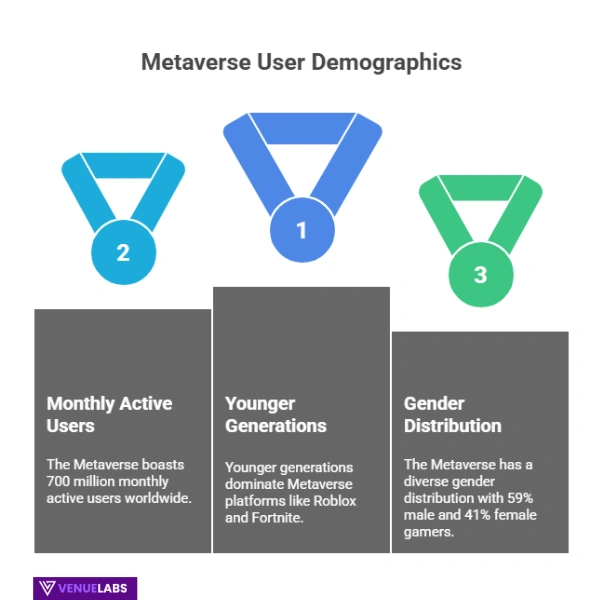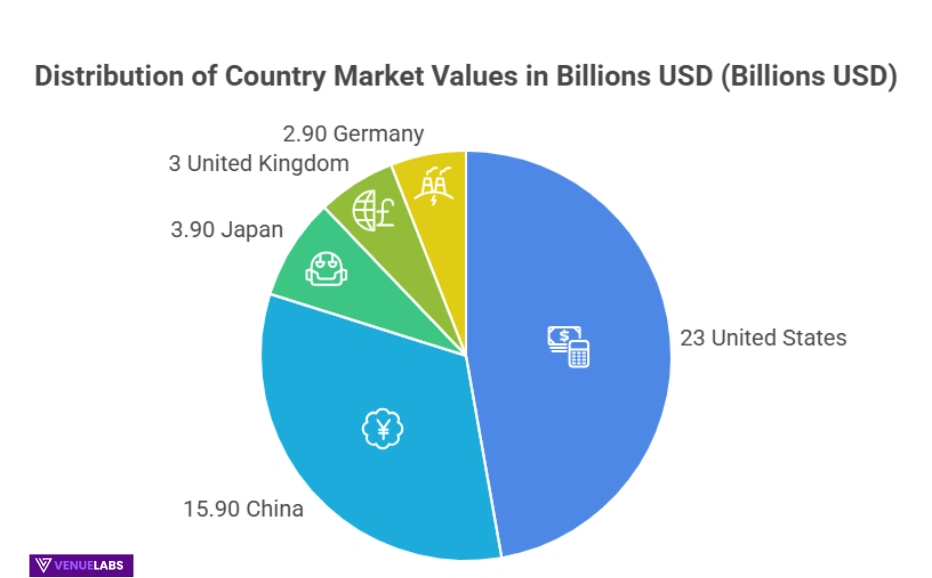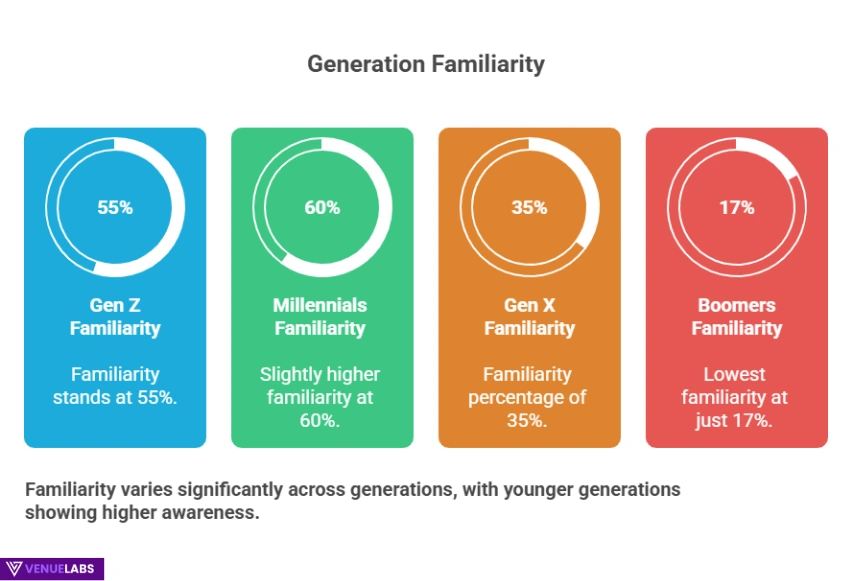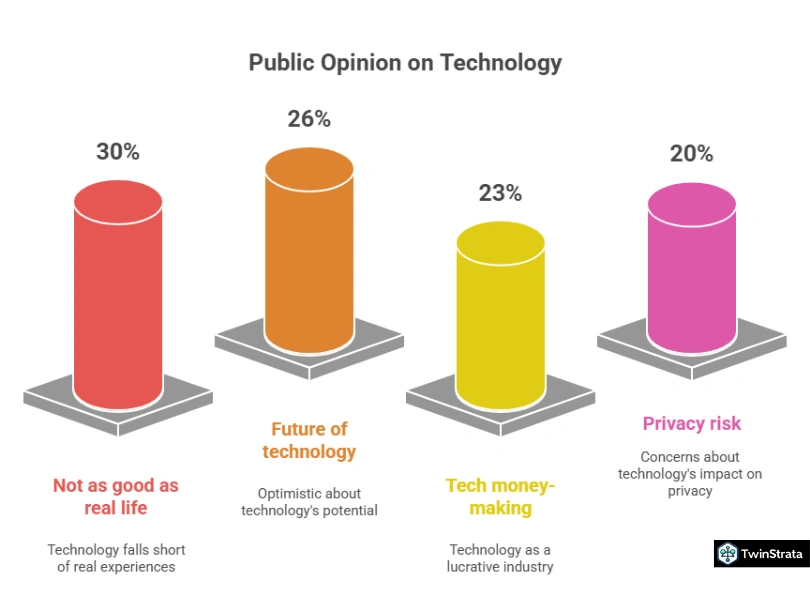The metaverse is transforming how we interact with the digital world. It’s a shared 3D virtual environment where people can engage with each other, objects, and businesses in real-time.
It’s not just the next evolution of the internet—it’s a fully immersive experience that incorporates Virtual Reality (VR), Augmented Reality (AR), Artificial Intelligence (AI), blockchain, and social platforms.
In the metaverse, you can meet friends or colleagues as avatars, attend events without leaving your home, shop for virtual or real items, and even work in a virtual office.
As the metaverse continues to evolve, the world is seeing rapid adoption across various sectors like gaming, finance, healthcare, education, and retail. Below is a comprehensive look at the key statistics and trends shaping the metaverse in 2025.

Quick Summary of Metaverse Statistics 2025
Here are the top highlights:
- Market Size: The metaverse market is valued at $94.5 billion in 2025.
- Projected Growth: It is expected to reach $936.6 billion by 2030.
- Gaming: The gaming industry makes up 42% of the metaverse market.
- Awareness: 74% of internet users worldwide are familiar with the term “metaverse.”
- Generational Trends: 68% of Gen Z report feeling more “free” in the metaverse.
- Data Privacy: 47% of users are concerned about data privacy.
- Business Investment: 62% of companies are investing in metaverse-related projects.
- VR Headsets: Sales of VR headsets are expected to exceed 25 million units worldwide in 2025.
Also read about: Fortnite Statistics
Metaverse Market Size & Growth

The metaverse is growing rapidly. Below is a breakdown of its market size from 2021 to 2030.
| Year | Market Size (USD) |
|---|---|
| 2021 | $63 billion |
| 2023 | $67 billion |
| 2024 | $82 billion |
| 2025 | $94.5 billion |
| 2030 (projected) | $936.6 billion |
Source: Statista.
Takeaway: The metaverse economy is expected to grow 10x over the next five years.
Industry Breakdown of the Metaverse Economy
Different industries contribute differently to the metaverse’s economic landscape. Here’s a breakdown of the major contributors in 2025:
| Industry | % Contribution (2025) |
|---|---|
| Gaming | 42% |
| Social Media & Networking | 18% |
| E-commerce & Retail | 12% |
| Finance & Banking | 8% |
| Education | 7% |
| Healthcare | 5% |
| Others (Real Estate, Events, Travel) | 8% |
Insight: While gaming continues to lead, sectors like finance, education, and healthcare are making significant strides in adopting metaverse technology.
Also read about: Meta AI Users Statistics
Global Awareness & Usage
The metaverse is gaining recognition globally. Here are the key statistics related to awareness and usage:
- 74% of internet users worldwide are familiar with the term “metaverse.”
- 39% have already tried some form of metaverse platform (such as Roblox, Decentraland, Meta Horizon).
Metaverse Usage by Region
| Region | % Users Who Have Tried Metaverse |
|---|---|
| Asia-Pacific | 51% |
| North America | 46% |
| Europe | 37% |
| Middle East | 29% |
| Africa | 18% |
Insight: Asia-Pacific leads in metaverse usage (51%), with North America (46%) and Europe (37%) following closely.
Generational Divide in Metaverse Usage

The metaverse is primarily driven by younger generations, but older users are slowly catching up. Here’s the generational breakdown of metaverse participation:
- Gen Z (ages 10-25): 68% report spending time in metaverse platforms weekly.
- Millennials (ages 26-41): 44% participate occasionally.
- Gen X (ages 42-55): 21% are active in the metaverse.
- Baby Boomers (ages 55+): Only 8% have tried the metaverse.
Observation: The metaverse is youth-driven, but older generations are increasingly joining for work and healthcare-related purposes.
Gaming & Entertainment in the Metaverse
Gaming continues to dominate the metaverse economy, making up 42% of the total market share. The metaverse is also home to popular entertainment events, such as virtual concerts and live events.
Top Gaming and Entertainment Statistics:
- Roblox has over 250 million monthly active users.
- Fortnite regularly hosts events with over 14.4 million concurrent players.
- Virtual concerts, such as Travis Scott’s concert in Fortnite, attracted 12.3 million attendees.
Insight: Entertainment is proving to be the social glue of the metaverse, with gaming and virtual events driving a large portion of user engagement.
E-commerce in the Metaverse
E-commerce is increasingly integrated into the metaverse, making up 12% of the metaverse market. Virtual try-ons are a key feature, especially among Gen Z consumers.
Key E-commerce Insights:
- 71% of Gen Z users prefer virtual try-ons before making a purchase.
- Nike’s Nikeland in the metaverse has garnered over 25 million visits.
- Luxury brands such as Gucci and Louis Vuitton have successfully sold digital goods, earning millions from virtual items.
Insight: Virtual shopping experiences are transforming retail, especially for fashion and luxury brands.
Banking & Finance in the Metaverse
The financial sector is making its mark in the metaverse, contributing 8% to the economy. Banks and financial institutions are leveraging the metaverse for virtual banking and investment services.
Banking and Finance Insights:
- JP Morgan has opened its Onyx Lounge in Decentraland.
- HSBC and Standard Chartered have purchased land in metaverse platforms.
- 65% of users say they would prefer virtual banking for investments and transactions.
Insight: Virtual banking is gaining traction, offering efficient and immersive ways to manage investments and financial services.
Education in the Metaverse
Education is another growing sector within the metaverse, making up 7% of the market. Virtual learning experiences are becoming more engaging and accessible.
Key Education Insights:
- By 2025, 30% of universities worldwide will use metaverse technology for teaching.
- 75% of students find VR learning more engaging than traditional classrooms.
- Popular subjects in the metaverse include medicine, engineering, architecture, and design.
Insight: The metaverse is revolutionizing education, particularly in fields that benefit from immersive, hands-on learning experiences.
Healthcare in the Metaverse
Healthcare is emerging as a key sector, contributing 5% to the metaverse economy. Virtual Reality (VR) and other metaverse technologies are being used for remote surgeries and patient training.
Healthcare Insights:
- Doctors use VR for remote surgeries and training.
- VR therapy is used to treat PTSD, anxiety, and phobias.
- 40% of hospitals in developed countries are testing metaverse solutions.
Insight: The metaverse offers significant potential for improving healthcare services, from training professionals to offering new treatment methods.
Devices Driving the Metaverse
The metaverse is powered by various devices, with Virtual Reality (VR) headsets, Augmented Reality (AR) glasses, and mobile AR apps being the primary gateways for users.
Device Adoption for the Metaverse:
| Device | Global Users 2025 |
|---|---|
| VR Headsets | 25 million |
| AR Glasses | 15 million |
| Haptic Gloves & Suits | 2.5 million |
| Mobile AR Apps | 1.2 billion |
Insight: While VR headsets are growing rapidly, mobile AR apps continue to be the most accessible entry point for most users.
Concerns in the Metaverse

As the metaverse grows, there are valid concerns among users. The most common worries include:
- 47%: Concerns about data privacy and tracking.
- 42%: Issues related to harassment and safety in virtual worlds.
- 35%: The high cost of devices.
- 28%: Concerns about addiction and overuse.
Insight: Data privacy, harassment, and affordability are the biggest concerns, which must be addressed as the metaverse continues to expand.
Companies Investing in the Metaverse
As the metaverse grows, companies across various industries are investing heavily in the space. 62% of global companies are already involved in metaverse-related projects.
Major Companies Involved:
- Meta, Microsoft, Google, Nvidia, Epic Games, Roblox, and Tencent.
- In India, major tech firms like TCS, Infosys, and Wipro are developing enterprise metaverse solutions.
Insight: The metaverse is becoming an area of strategic investment for major tech giants.
Revenue Streams in the Metaverse
Various revenue models are emerging within the metaverse, with companies earning money through gaming, virtual real estate, and digital goods.
| Revenue Source | Share (%) |
|---|---|
| Gaming & In-game Purchases | 35% |
| Virtual Real Estate | 19% |
| Digital Goods & NFTs | 15% |
| Advertising | 12% |
| Subscription Services | 10% |
| Education & Training | 9% |
Insight: Gaming and virtual real estate are the largest revenue generators, with companies also profiting from digital goods and NFTs.
Role of AI in the Metaverse

AI plays a pivotal role in enhancing the metaverse experience. 71% of metaverse platforms use AI for avatar creation, chatbots, and world-building.
Insight: AI personalizes user experiences and moderates toxic behavior, while AI-driven avatars are replacing basic customer service roles.
FAQs About Metaverse Statistics
1. Is the metaverse just for gamers?
No. It now encompasses finance, healthcare, education, shopping, real estate, and business meetings.
2. Do I need an expensive VR headset to enter the metaverse?
Not always. While headsets offer the best experience, mobile devices and AR apps also provide access.
3. Can I make real money in the metaverse?
Yes. People earn by selling digital goods, hosting events, or trading virtual land and NFTs.
4. Is the metaverse safe for kids?
Safety is a concern. Platforms are working on improving safety measures, including age filters and anti-harassment tools.
Also Read:
- TikTok Ad Revenue Statistics
- Chatbots Statistics
- Smartphone Usage Statistics
- Generative AI Statistics
- Marketing Automation Statistics
Conclusion: Why These Metaverse Statistics Matter
The metaverse in 2025 is no longer just a buzzword—it’s a $94.5 billion economy that spans gaming, finance, education, healthcare, and retail.
For businesses, it’s an opportunity to reach new customers in virtual spaces. For students, it means immersive learning. For banks and healthcare providers, it’s a chance to offer more efficient services.
Despite challenges related to privacy, safety, and affordability, the growth of the metaverse shows one thing: it is here to stay.
Whether you’re a professional, an entrepreneur, or a student, exploring the metaverse now is the best way to future-proof your career and business.
Source: Fortune Business insights.
